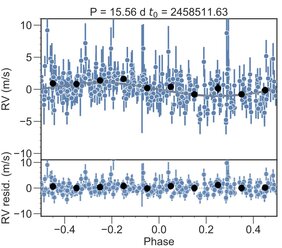Heidelberg astronomers have detected a planet orbiting its host star in its habitable zone just 30 light-years away. The discovery was made with measurements carried out with the spectrograph CARMENES, with which Spanish and German scientists have been searching for habitable planets since 2016. The study has now been published in "Astronomy & Astrophysics".
The new planet named "Wolf 1069 b" was discovered using the so-called radial velocity method. For this purpose, the periodic motion of the star and its planet around the common center of gravity is measured. The team of researchers led by Diana Kossakowski from the Max Planck Institute for Astronomy in Heidelberg observed the star regularly with CARMENES for almost four years. The instrument splits the star's light into its spectral colors. From the periodic shift of dark spectral lines that occurs when the star moves on its orbit towards or away from the observer on Earth, the planet was thus able to be detected indirectly. This is a kind of continuing the history of astronomy in Heidelberg, because the system's home star bears the name of Max Wolf, the founder and first director of the Landessternwarte on the top of Königstuhl mountain, who first catalogued and described the star in 1920.
"Wolf 1069 b orbits its star in just 15.6 days. In our solar system, this orbit would lie far within Mercury's orbit. However, since the star has only about one-sixth of the mass of the Sun, its luminosity is significantly lower than that of our Sun," explains co-author Dr. Jonas Kemmer, a scientist at the Königstuhl State Observatory, which belongs to the Center for Astronomy at Heidelberg University. "The conditions are so favourable that liquid water is possible to exist on the planet's surface. This is also referred to as a planet in the habitable zone."
Among other things, Dr. Kemmer supported the research team in modeling the data. In spring 2022, he completed his doctorate at the State Observatory on the search for low-mass planets around M stars.
Whether the planet is actually habitable, however, also depends on other factors that will be examined in more detail in a future study. Above all, the host star is hardly prone to solar storms, which makes an intact atmosphere of the planet more likely. In addition, initial simulations of the prevailing climate suggest that Wolf 1069 b could provide moderate temperatures and liquid water on the surface for a wide variety of atmospheric compositions and surface types.
Such planets in the habitable zone are interesting for scientists who deal with the formation of Earth-like planets. Contrary to the prediction of current models, however, there seem to be no other planets with similar mass and orbital period in this system apart from Wolf 1069 b. The authors of the study explain this by the fact that major collisions between protoplanets could have occurred in the late formation phase of the planetary system and only Wolf 1069 b survived this. The high accuracy of the radial velocity measurements, which is possible due to the low activity of the host star, makes the system particularly suitable for ruling out the presence of other previously undiscovered planets and thus testing this hypothesis. "The next-generation instruments that are currently being developed and built will help us. With them, it will also be possible to discover even more potentially life-friendly worlds like Wolf 1069 b," concludes Diana Kossakowsk. She and her team are excited and looking forward to seeing what other fascinating planets they will find in the future.
ORIGINAL PUBLICATION
The CARMENES search for exoplanets around M dwarfs, D. Kossakowski, M. Kürster, T. Trifonov, Th. Henning, J. Kemmer et al., Astronomy & Astrophysics, 2023, DOI https://doi.org/10.1051/0004-6361/202245322
BACKGROUND INFORMATION
CARMENES is a novel astronomical instrument that can be used to detect Earth-like planets around low-mass stars. It is used at the 3.5-metre reflecting telescope of the Calar Alto Observatory near Almería in southern Spain. The highly complex device was planned and built by an international consortium of eleven German and Spanish institutions. Above all, scientists from the Landessternwarte are significantly involved in the construction and operation. They have built one of the two CARMENES spectrographs and are now responsible, among other things, for continuously monitoring and improving the quality of the data. Since 2016, German and Spanish scientists have been using CARMENES to search for planets around stars near the Sun. Cooperation partners are the universities of Göttingen, Hamburg and Heidelberg, the Max Planck Institute for Astronomy in Heidelberg, the Thuringian State Observatory Tautenburg, the Instituto de Astrofísica de Andalucía, the Institut de Ciències de l'Espai in Barcelona, the Instituto de Astrofísica de Canarias, the Universidad Complutense de Madrid, the Centro de Astrobiología Madrid, and the Centro Astronómico Hispano-Alemán (CAHA, Calar Alto Observatiorium). With the planet now discovered, the number of their new discoveries has risen to 33. Heidelberg University's participation in CARMENES was funded by the State of Baden-Württemberg, the German Research Foundation and the Klaus Tschira Foundation.
RELATED MEDIA INFORMATION
Press release of MPIA: https://www.mpia.de/aktuelles/wissenschaft/2023-02-wolf1069b
Homepage of the Landessternwarte Königstuhl: www.lsw.uni-heidelberg.de
Homepage of CARMENES Consortium: https://carmenes.caha.es
SCIENTIFIC CONTACT
Dr. Jonas Kemmer
Centre for Astronomy of Heidelberg University (ZAH)
Landessternwarte Königstuhl (LSW)
jkemmer(at)lsw.uni-heidelberg.de


